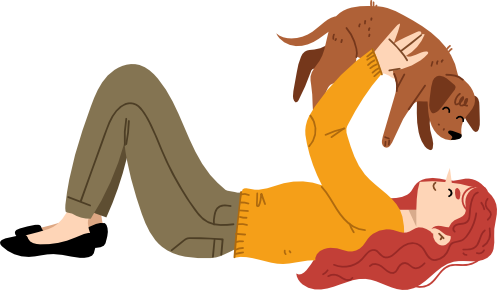Many dogs LOVE the car: it means parks, playtime, and adventure. But for other dogs, car rides are a dreaded occurrence. This can be confusing for owners, especially if car rides usually predict something good. If you’re always driving to the park, why would your dog hate being in the car?
Let’s discuss why your dog hates the car and what to do about it. There are two main reasons your dog hates the car:
- Your dog gets carsick, used to get carsick, or had another bad experience on a car ride.
- Your dog thinks that car rides predict bad things (like the vet).
Of course, this is a pretty simplistic view and not all dogs will fit neatly into one of these categories. But for the purposes of this article, let’s start here.
Helping A Carsick Dog Like the Car
Whenever I am helping a client whose dog hates the car, our first step is to explore carsickness. This is especially true if we can’t find a reason that their dog is scared of the car, like a recent scary accident. While some dogs with carsickness might pace, pant, drool, or otherwise make things obvious, not all will. I urge my clients to speak to their vet about a trial of anti-nausea medication. We call this diagnosis by treatment: if the medications help, we can deduce that nausea was part of the problem.
I do not recommend drugging dogs for car rides to make them sleepy or immobile: we want to treat the nausea, not knock the dog out.
Unfortunately, some dogs with carsickness will still be nervous in the car even when their nausea has been treated. If you think about it, this makes sense. Imagine that every time you got in the car for months, you felt terribly nauseous. Even if that nausea went away for a car ride or two, you’d still be apprehensive about riding in the car!
In that case, we need to treat carsick dogs the same way as the other dogs who hate the car. This involves much more training, and can take a while to implement.
Helping Teach a Dog to Tolerate Car Rides with Training
Once you’ve tested anti-nausea meds, you may still need to implement training to help your dog not hate the car anymore. Here are the steps to take to help your dog enjoy (or at least tolerate) car rides going forward:
- Make the car as comfortable as possible. Some dogs prefer a covered crate; others prefer to be able to see. Experiment to see which option makes your dog less nervous. A variety of different crates, seatbelts, and placement within the car may help you pinpoint the issue. It is also important to make car rides as low-stress as possible. Scolding your dog for crying can easily backfire by making car rides stressful! Similarly, if your only car rides head to the vet’s or other places your dog doesn’t like, your training is unlikely to succeed.
- Help your dog feel comfortable approaching the car. First things first: does your dog happily walk up to the car and get into the car? If not, we have to start there. In the meantime, cease car rides if at all possible. Every time you force your dog into the car, your training will take a step backwards. For this step, start by walking your dog around the car while feeding treats. If at any point your dog appears tense or stops eating treats, move farther from the car. Repeat daily until your dog happily marches right up to the car door.
- Teach your dog to get into the car. Once your dog is approaching the car readily, start opening the door and asking them to get inside. Like before, if at any point your dog appears nervous or stops eating, go back a few steps. For more serious cases, you may need to do several days of treat-feeding just while you touch the door handle, then open the door, then step towards the door, and so on. If you’re feeling stuck, odds are you’re going too fast and need to take even smaller steps. The exact procedure for getting your dog into the car will vary widely based on your dog’s size and your car design. If your dog is going to need to hop into the car, I suggest practicing a “hop up” cue on picnic tables, curbs, and other unrelated objects first before asking your dog to jump into the car. Build up your dog’s confidence with the cue in unrelated areas first!
- Gradually make car rides into a fun, easy thing. Once your dog is loading up into the car easily, it’s time for you to start getting into the car. Again, if at any point your dog gets nervous or stops eating treats, take a few steps backwards in your plan and reassess. Now it’s time for you to get in the car (give your dog a treat). Put on your seatbelt (treat). Turn the car onto accessory mode (treat). Take a break and come back tomorrow. It’s much better to go WAY TOO SLOW than to push too fast! Trust me. Now repeat the steps above, but turn the car on fully (treat). Put the car in gear (treat). Break. Start again at the first step the next session. Back out of the driveway (treat). Pull back into your driveway (get out of the car, throw a PARTY). Drive around the block (PARTY). Drive somewhere fun, but only if you’re 100% sure you can get your dog happily home or can walk home (PARTY). Add in driving distance, highways, speed bumps, etc.
If the article above doesn’t solve your problem, feel free to book a consultation in the menu bar above! We’d be happy to help troubleshoot and solve further.

